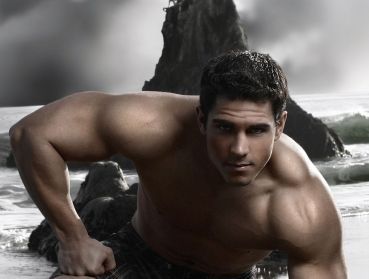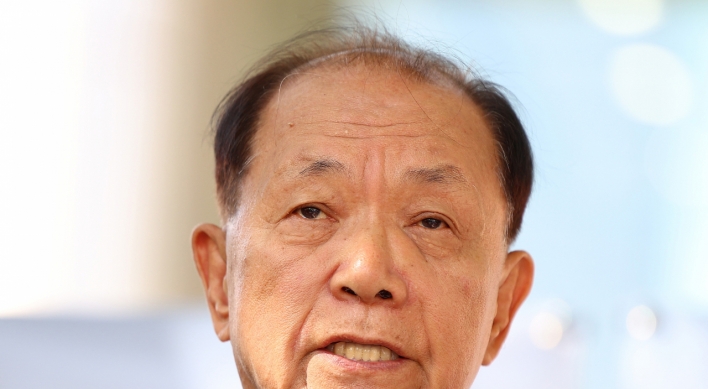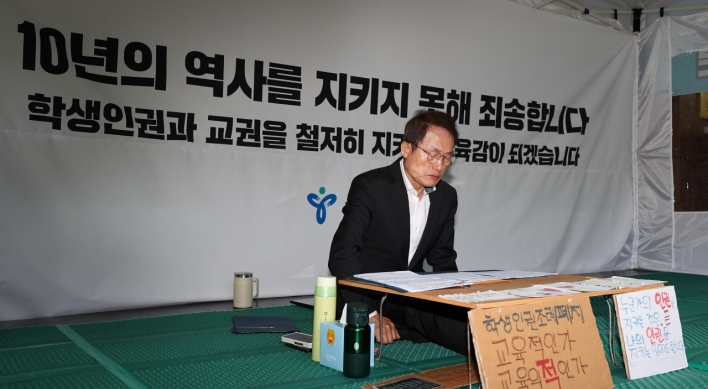
Spear hunting may not have given Neanderthals their powerful right arms; it may have come from scraping animal skins for clothes and shelters, researchers say.
Skeletons show Neanderthals, our closest known extinct relatives, had unusually strong right arms, as their right humerus -- the long arm bone associated with the biceps and triceps -- often possessed large anchor points thought to attach to powerful muscles, scientists said.
“Neanderthals have really interesting upper bodies,”researcher Colin Shaw, a biological anthropologist at the University of Cambridge in England, told LiveScience. “If you and I are both right-handed, you’d expect 4 to 13 percent asymmetry between our arms.”
“Neanderthals have up to 50 percent or more asymmetry. They were doing something with their dominant arms that were either more intense or repetitive or both than we do today.”
Shaw thought to test a prevalent theory that held the arms might have grown strong through regular underhanded spear-thrusting.
The research measured electrical activity in the muscles of 13 right-handed men as they performed three different spear-thrusting tasks, and also analyzed the men as they carried out different scraping tasks on carpet.
The researchers found spear-thrusting led to significantly higher muscle activity on the left side of the body than on the right, opposite to what is seen in Neanderthal fossils.
“Spear-thrusting did not appear to explain the mystery,”Shaw said.
In comparison, scraping tasks led to much higher muscle activity on the right side than on the left, he said.
“While hunting was important to Neanderthals, our research suggests that much of their time was spent performing other tasks, such as preparing the skins of large animals,”Shaw said.
“If we are right, it changes our picture of the daily activities of Neanderthals,“he said. “This is a lot more mundane than hunting big game all the time, but it shows forethought to prepare skins for use throughout the year.”(UPI)
<관련 한글 기사>
‘몸짱’원시인, 무지막지한 팔힘의 비밀은 ‘주걱질’
네안데르탈인의 강력한 오른팔 힘은 어디서 온 것일까? 창술 대신 의복과 주거를 위한 동물 가죽을 만지는 작업이 힘센 오른팔을 주었을 지도 모른다.
원시시대에 멸종했지만 현생 인류의 가장 가까운 친족으로 알려진 네안데르탈인의 화석을 살펴보면, 오른팔이 굉장히 발달했었다는 것을 알 수 있다. 과학자들에 따르면 그들은 이두박근과 삼두박근이 연결된 상완골(윗팔)을 고정점으로 강한 근육을 지녔던 것으로 나타났다.
캠브릿지대학교 생체고고학자 콜린 쇼는 라이브사이언스지에 “네안데르탈인은 정말 흥미로운 상체를 가졌습니다”라고 언급했다. 그는 보통 현생 인류가 오른손잡이라면 양팔이 4에서 13 퍼센트 정도 비대칭인 반면 네안데르탈인은 50 퍼센트까지 비대칭인 것으로 나타난다고 밝혔다.
“그들은 우리들에 비해 주로 사용하는 팔로 뭔가 강도 높은 작업을 반복했을 겁니다.”
쇼는 네안데르탈인의 특별한 오른팔이 창술 때문이라는 지금까지 널리 퍼져있는 이론에 대한 검증을 시도했다.
먼저 열 세 명의 오른손잡이 남성들을 대상으로 그들이 세 종류의 창던지기를 수행하는 동안 근육의 전기적 활동 측정했다. 또한 세 종류의 카페트를 긁어내는 작업을 하는 동안의 전기적 활동을 분석했다.
결과 창던지기는 신체 오른쪽보다 왼쪽의 근육 활동이 눈에 띄게 활발해졌다. 이는 네안데르탈인의 화석과 상반되는 결과이다.
“창던지기로는 이 미스테리를 설명할 수 없습니다.”
이와 비교하여, 긁어내기 작업은 신체 오른쪽의 근육 활동을 더욱 활발하게 만들었다.
“물론 사냥은 네안데르탈인에게 중요한 일과였습니다. 하지만 우리 연구는 그들이 다른 작업을 하는 데에 훨씬 더 많은 시간을 쏟았다는 것을 암시하죠. 예를 들면 동물 가죽을 다듬는 일 같은 것들입니다.”
그는 “만약 우리의 가설이 옳다면, 우리가 생각해온 네안데르탈인의 일상이 바뀔 겁니다. 그들은 맹수 같은 대형 사냥감을 잡는 것처럼 짜릿한 일 대신 일 년 내내 사용할 가죽을 손질하는 단조로운 일상을 보내는 일이 훨씬 많았을 것입니다”라고 덧붙였다.
코리아헤럴드(khnews@heraldcorp.com)
Skeletons show Neanderthals, our closest known extinct relatives, had unusually strong right arms, as their right humerus -- the long arm bone associated with the biceps and triceps -- often possessed large anchor points thought to attach to powerful muscles, scientists said.
“Neanderthals have really interesting upper bodies,”researcher Colin Shaw, a biological anthropologist at the University of Cambridge in England, told LiveScience. “If you and I are both right-handed, you’d expect 4 to 13 percent asymmetry between our arms.”
“Neanderthals have up to 50 percent or more asymmetry. They were doing something with their dominant arms that were either more intense or repetitive or both than we do today.”
Shaw thought to test a prevalent theory that held the arms might have grown strong through regular underhanded spear-thrusting.
The research measured electrical activity in the muscles of 13 right-handed men as they performed three different spear-thrusting tasks, and also analyzed the men as they carried out different scraping tasks on carpet.
The researchers found spear-thrusting led to significantly higher muscle activity on the left side of the body than on the right, opposite to what is seen in Neanderthal fossils.
“Spear-thrusting did not appear to explain the mystery,”Shaw said.
In comparison, scraping tasks led to much higher muscle activity on the right side than on the left, he said.
“While hunting was important to Neanderthals, our research suggests that much of their time was spent performing other tasks, such as preparing the skins of large animals,”Shaw said.
“If we are right, it changes our picture of the daily activities of Neanderthals,“he said. “This is a lot more mundane than hunting big game all the time, but it shows forethought to prepare skins for use throughout the year.”(UPI)
<관련 한글 기사>
‘몸짱’원시인, 무지막지한 팔힘의 비밀은 ‘주걱질’
네안데르탈인의 강력한 오른팔 힘은 어디서 온 것일까? 창술 대신 의복과 주거를 위한 동물 가죽을 만지는 작업이 힘센 오른팔을 주었을 지도 모른다.
원시시대에 멸종했지만 현생 인류의 가장 가까운 친족으로 알려진 네안데르탈인의 화석을 살펴보면, 오른팔이 굉장히 발달했었다는 것을 알 수 있다. 과학자들에 따르면 그들은 이두박근과 삼두박근이 연결된 상완골(윗팔)을 고정점으로 강한 근육을 지녔던 것으로 나타났다.
캠브릿지대학교 생체고고학자 콜린 쇼는 라이브사이언스지에 “네안데르탈인은 정말 흥미로운 상체를 가졌습니다”라고 언급했다. 그는 보통 현생 인류가 오른손잡이라면 양팔이 4에서 13 퍼센트 정도 비대칭인 반면 네안데르탈인은 50 퍼센트까지 비대칭인 것으로 나타난다고 밝혔다.
“그들은 우리들에 비해 주로 사용하는 팔로 뭔가 강도 높은 작업을 반복했을 겁니다.”
쇼는 네안데르탈인의 특별한 오른팔이 창술 때문이라는 지금까지 널리 퍼져있는 이론에 대한 검증을 시도했다.
먼저 열 세 명의 오른손잡이 남성들을 대상으로 그들이 세 종류의 창던지기를 수행하는 동안 근육의 전기적 활동 측정했다. 또한 세 종류의 카페트를 긁어내는 작업을 하는 동안의 전기적 활동을 분석했다.
결과 창던지기는 신체 오른쪽보다 왼쪽의 근육 활동이 눈에 띄게 활발해졌다. 이는 네안데르탈인의 화석과 상반되는 결과이다.
“창던지기로는 이 미스테리를 설명할 수 없습니다.”
이와 비교하여, 긁어내기 작업은 신체 오른쪽의 근육 활동을 더욱 활발하게 만들었다.
“물론 사냥은 네안데르탈인에게 중요한 일과였습니다. 하지만 우리 연구는 그들이 다른 작업을 하는 데에 훨씬 더 많은 시간을 쏟았다는 것을 암시하죠. 예를 들면 동물 가죽을 다듬는 일 같은 것들입니다.”
그는 “만약 우리의 가설이 옳다면, 우리가 생각해온 네안데르탈인의 일상이 바뀔 겁니다. 그들은 맹수 같은 대형 사냥감을 잡는 것처럼 짜릿한 일 대신 일 년 내내 사용할 가죽을 손질하는 단조로운 일상을 보내는 일이 훨씬 많았을 것입니다”라고 덧붙였다.
코리아헤럴드(khnews@heraldcorp.com)




![[KH Explains] No more 'Michael' at Kakao Games](http://res.heraldm.com/phpwas/restmb_idxmake.php?idx=644&simg=/content/image/2024/04/28/20240428050183_0.jpg&u=20240428180321)












![[Herald Interview] Mistakes turn into blessings in street performance, director says](http://res.heraldm.com/phpwas/restmb_idxmake.php?idx=652&simg=/content/image/2024/04/28/20240428050150_0.jpg&u=20240428174656)
